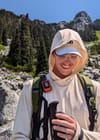A Dummies Guide to Skiing Mt. Adams
It's me, I'm the dummy
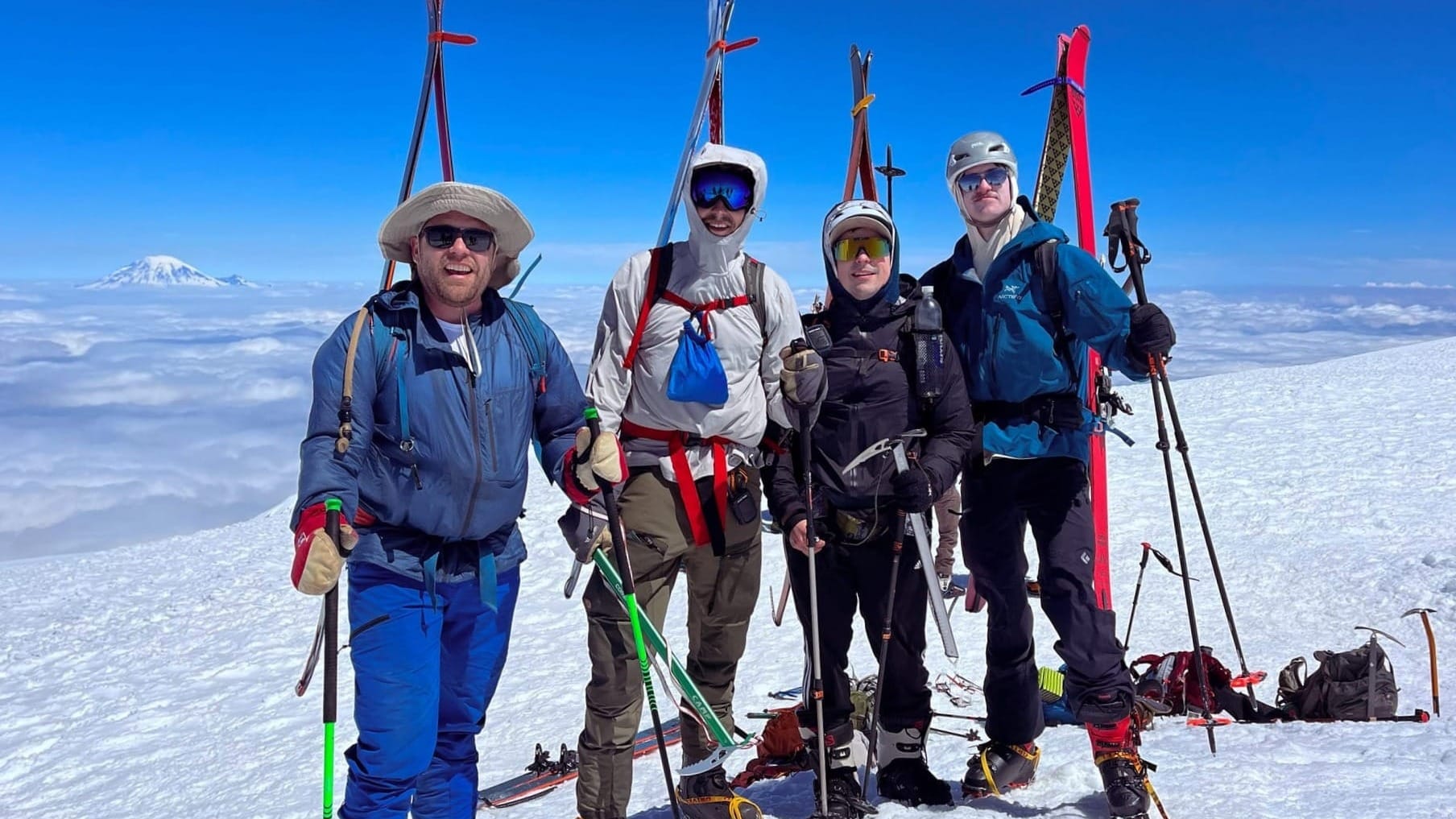
Check out a full length video on the ascent/descent here!
I have fallen (somewhat accidentally) into an annual tradition of finishing my ski season on Mt. Adams. For the past three years I have made the five hour pilgrimage from Seattle, down to the Oregon border, along the Columbia River, and back up the long fire road into the Gifford Pinchot National Forest where the volcano stands massive over the Trout Lake Valley.
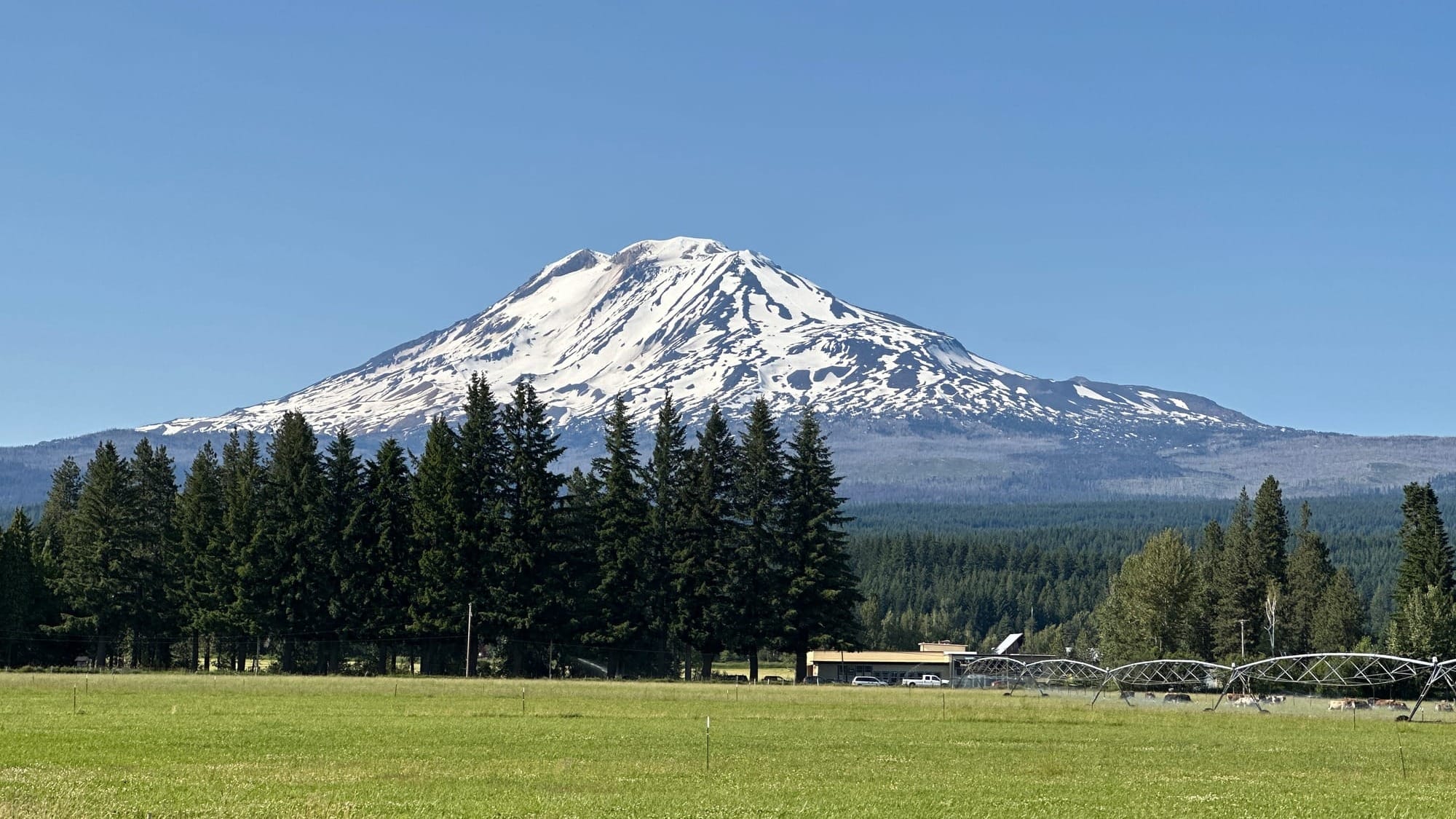
Mt. Adams (or "Pahto") stands at 12,281 ft tall, with an impressive 8,116 ft prominence, making it the second tallest mountain in Washington. There are a handful of named ski descents on the mountain, with the most iconic being the Southwest Chutes, a set of steep snow bands dropping off from Pikers Peak and providing over 3,000 ft of continuous 35° skiing. Beyond the jaw dropping stats and beauty of the line, it also holds snow well through the early summer (the SW aspect making for particularly good "corn" harvesting) and does not require crossing any real glaciated terrain or hazards like many comparable ski lines on other PNW volcanos.

The South Climb, which is by far the most popular route up the mountain due to easy road access and its direct nature, takes you past a few key features which should be highlighted to familiarize you with the route:
- The Cold Springs Campground, which gives you direct drivable access to 5,500 ft (at least 1,000 ft higher than any other access point). To get here you'll have to drive to Trout Lake, take the long rutted gravel road to Morrison Creek, and then drive up a sketchy and rocky single lane road up to the parking lot. Once you are there you'll find plentiful parking, a well maintained pit toilet, and a friendly camaraderie from the other prospective climbers.
- Timberline camp, a backcountry camp spot about 1,000 ft above Cold Springs, where the "Round the Mountain" trail intersects with the South Climb trail. This (from my experience) is almost always where the snow line sits when the mountain is in good skiable conditions. If you are stashing shoes, this is a great place to do so since all exits will lead you back to this spot.
- The "Lunch Counter" or Suksdorf Ridge. This is where people attempting the mountain in two or more days tend to camp as there are plentiful flat and dry spots to pitch a tent. If you are doing it in a single push you'll most likely arrive here in the morning, but it's a great spot to eat "lunch" and rest up before starting up the most formidable part of your day, the imposing climb up to Pikers Peak
- The aforementioned Pikers Peak, a notorious sub peak of Adams, hiding the true summit for much of the climb and requiring most to boot for nearly 2,000 ft up a gradually increasing 20° -> 35° slope. It feels endless while you are on it, but you will never be alone, on all of my attempts I have easily seen 50 other people conga-lined up the set booter, all sharing in the suffering. You'll get a respite on top of Pikers, and find yourself with a quarter mile of flat walking to where the true summit sticks out 1,000 ft above you. While the last climb is shorter and far less demanding, if you are unfamiliar with altitude this is where it hits.
- The final point of interest is the summit itself. While most people will congregate where the old fire lookout once stood (to get the best photos of Mt. Rainier and Mt. St. Helens), the true summit sits a few hundred feet to the east. Make sure to head that way if you are peak-bagging and then you can transition to skis for a great ride out.
If you don't want my personal history with the line and just the beta, feel free to skip ahead to "So, What Do I Need To Know?"
My introduction to Adams
I was introduced to Mt. Adams by a friend, Alex, during my first real year of ski touring. Sometime in the early spring of 2023 he floated the idea of skiing the SW chutes when the road to the south climb trailhead finally melted out. When I found out that wouldn't be until late May or early June my newly minted PWN brain short circuited. The idea that skiing was possible in months I had previously associated only with good hiking and rock climbing weather was a hard one to grasp.
A quick bit of research on the route and I found myself staring down the barrel of a 5,000 ft climb to reach the top of the chutes and a 7,000 ft climb if we wanted to summit. At this point I'd only been in Washington for two "seasons" and I was early in my progression from "moderate-hiker-fit" to "mountaineer-fit". That much gain seemed lightyears beyond what I felt I was capable of. My buddy had already been to the summit once and really only wanted to tag the chutes so we settled on the plan to just make it to Piker's to ski down, only considering the summit if I felt up for it on the day. Feeling slightly better, but still nervous about the prospect of having to keep up with him on that big of a day, I began rigorously training for the uphill.
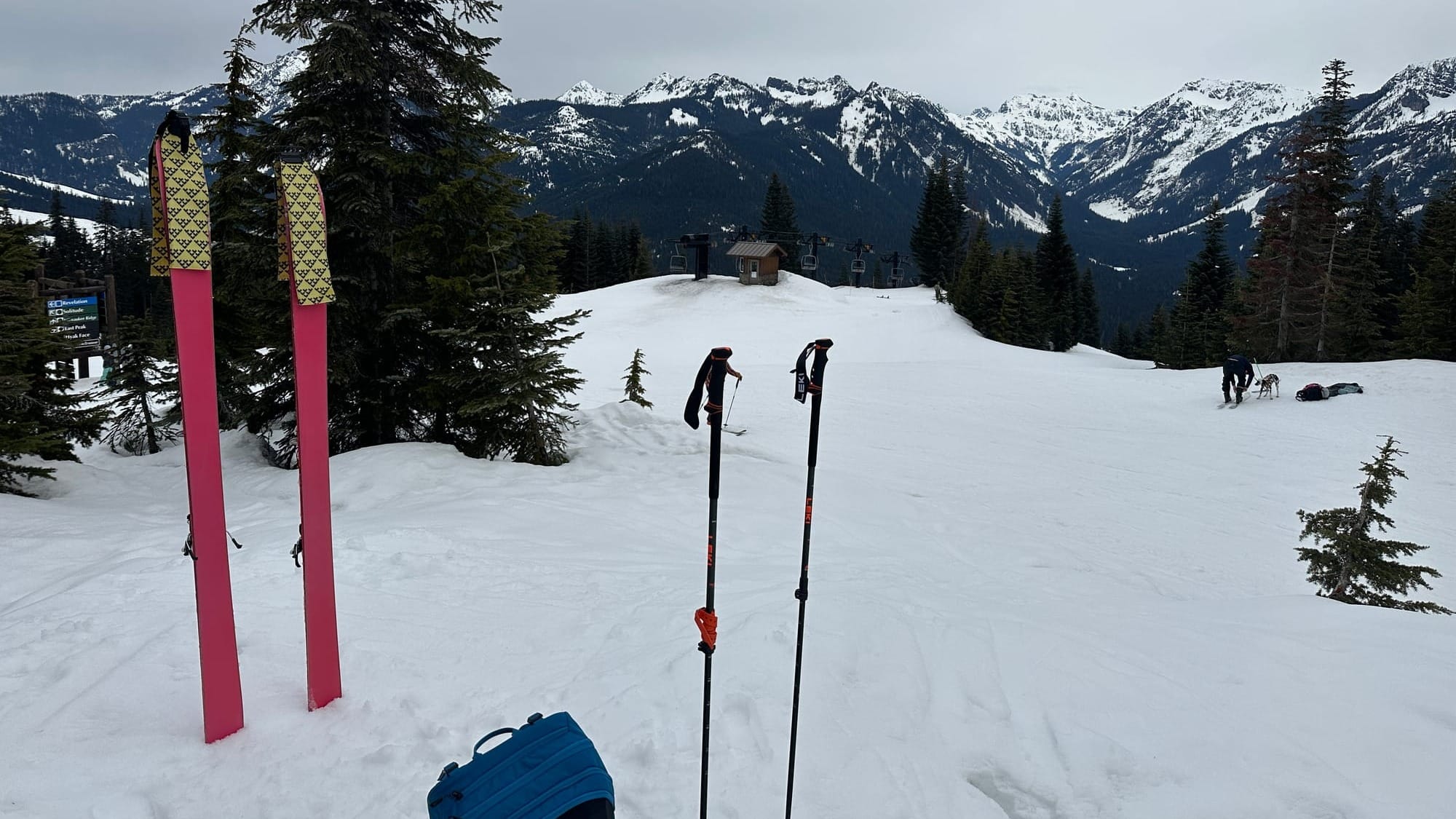
I'm certainly no expert on training, and was even less so at this point. I started by joining my wife running – slowly upping my running mileage in the city, getting up to maybe 10 or 12 miles a week – as well as spending at least one day a week in Snoqualmie, touring laps up Hyak Face.
Hyak, also known as Summit East, is (in my opinion) a near perfect training ground for ski touring. A short drive from the city, a 1,000 ft rise (making each lap an easy benchmark), and it closes early in the season giving tourers unlimited access to routes on open clear terrain. Over the few weekends I had before the objective I would drive out, by myself, and try to increase my "laps" by one each time I went. Trying my best to maintain at least a pace of 1,000 ft per hour (including my transitions and skiing down) to be able to match my friend's speed. By the beginning of May when the face became too melted out to ski I had gotten up to five laps (or 5,000 ft of gain) in under 5 hours. I was feeling cautiously optimistic, maybe not for the summit (7,000 was still such a scary number), but at least I had given my body an idea of what getting to the top of the chutes would feel like.
The day finally came, June 3rd, 2023. A beautiful blue sky and warm weather beckoned us south and we followed. Alex and I drove up the night before, and one of his friends drove up from Oregon to meet us. Sadly, the road still hadn't fully melted out to Cold Springs, an infuriatingly narrow band of snow stretched along the road making it impassible to mortal vehicles. Instead, we ended up camping for the night at the lower campground, Morrison Creek, which would add two miles and almost 1,500 ft of extra gain. Despite the setback we assessed our plan and determined we were all still up for the challenge, so we geared up at four in the morning and set out toward the mountain.

We made ground quickly on the Shorthorn Trail that left directly from Morrison, our ski boots covered in dirt and mud from the two miles on trail. We made it to the snow line within an hour of leaving camp, where we could finally take the skis off our backs and start skinning. We continued upward, not following any specific track, but instead pointing ourselves toward the south end of the mountain and watching for snow-free obstacles as we went. The experience was magical. The pink and yellow sunrise shimmering in the sky, lighting up Mt. Hood on the horizon. The mountain ahead keeping us in its looming shadow. Our skins whining against the snow, hardened and rippled from melting and refreezing over and over again.
Somewhere around 7,500 ft, as the sun crested the ridge and put us in full yellow warmth, we were going up a particularly steep and icy hill along the main route. Ski crampons were a piece of gear not yet in my kit, which meant there was no way I was going to be able to side-hill up the crusty slope. Instead, I took off my skis and donned my boot crampons for the first time and hiked up the hill. The other two in my party had already been skinning with crampons and continued up the slope, cutting shallow switchbacks and zig-zagging up. I made it to the top only a bit behind Alex, and together we awaited his friend who was moving a bit slower. After only a minute or two we heard a scared shout and a skier from another group below us calling out, "Are you okay?".
Our teammate had slipped while skinning and slid all the way back down the slope, easily two or three hundred feet. Luckily, they had not been in the path of any of the exposed rocks and made it out injury free, but were rightfully shaken by the experience. Together we decided to continue on, but our new cautious pace and the time lost from collecting strewn gear meant our plans for the day had most likely been dashed. At the Lunch Counter we decided we were too far behind schedule and skied back down the South Climb, bouncing between wallowing sun cups and decent slushy skiing.

The trip ended bittersweet, the setting was incredible and I had done well physically, despite not having done the most challenging part. At the time I remember feeling like I could have kept going for hours or picked up the pace significantly. It was my first time really spring touring and my first time on a volcano, I had caught the bug for sure. I knew that wouldn't be my only attempt so I logged it away for next season when I could come back even more prepared.
The Comeback Tour
The next year (2024) I made friends with another crew who were touring pretty regularly and managed to put lots of miles on my shiny red crows throughout the winter. This group had their eyes set firmly on Mt. Baker, and I too got deep into prepping for it. We all took crevasse rescue courses and planned for that attempt throughout the spring with a dialed focus. Mt. Adams was still sitting somewhere in my subconscious, a neat idea, but now far second to the new goal. Our focus and practice paid off, and we skied the Coleman-Deming in May to great success, allowing Baker to overtake Adams as my first volcano summit.
I spent the rest of May and June backpacking, climbing, and hiking and had managed to put skiing almost completely out of my mind. One day near the end of June though I saw a message pop up in a Facebook group I used for skiing. Someone was looking for a team to join them in skiing the Southwest Chutes. The date they were talking about was in... July!? I scrambled, reading reports, finding recent pictures of the mountain, checking weather. It was in? Again, I was shocked at how little I knew. How unattuned I still was to the seasons and weather here, despite feeling like I learned so much in my lead up to Baker. I threw my name in the chat and enthusiastically joined three complete strangers (after a quick vetting of their prior experiences – I was easily the least competent) and started unpacking all of my ski gear from it's storage boxes.

We drove up June 29th (nothing like 5 hours in a car with strangers to really get to know each other!) and planned another single strike mission up to the summit and then down the chutes. This time we had no trouble getting up to the Cold Springs trailhead, and managed five hours of sleep before an early wakeup call at 3:00 AM. Now, somewhat familiar with the route and armed with more experience and proper gear, I was able to move confidently alongside my new partners up the south climb.
We pushed past Timberline in well under an hour, slogged our way up to the Lunch Counter, and started our climb up to Pikers. This was where my familiarity ran out. We had been able to skin the entirety of the route up to this point, even making it half way up Pikers before having to transition, but by 10,000 ft we were hiking up the slope with our crampons on and I was feeling the altitude.

I struggled far more with the elevation than I had on Mt. Baker. Whether it was the quick pace we were keeping or the continuous steep slope, by the time we made it to the summit push my head was pounding and I couldn't keep my heart rate down. Riding on adrenaline and excitement that had been compounding from the wild view and the camaraderie of new friends, I pushed through, heaving step after step to make it to the summit. I stayed only long enough to take a few photos and transition onto my skis, I was the first to depart the summit to try and find some relief from my swollen head.
Despite it being July 1st, the snow off of the summit was covered in a thick icy crust that resembled rime ice blown in waves over the mountain. The skiing was horrible for the first five or six hundred feet, my skis barely able to bite in and when they did the thick crust held onto them stopping me in my tracks. It was a decent sign for us though, despite having sat in the sun for a couple of hours it was firm at this altitude, that meant lower down where the temperatures were higher it would hopefully be softening just enough for good skiing. By the time I reached the long flat traverse to the chutes the pain in my head and almost completely subsided and my mood improved dramatically. I was finally going to ski the chutes!

The skiing once we entered was magical, completely living up to the hype of the line. We arrived at the top just after noon to a bit of ice at the entrance and beautiful corn throughout the middle section. I ripped down, hooting and hollering as we made long arcing turns for a thousand feet, each of us pausing just enough to catch our breaths and take videos of one another. The temperature was rising quickly though as we descending and I was caught off guard by an extreme and sudden warming of the snow under my feet. In an instant the snow went from wonderful skiable slush to rotten goo. My skis sunk into the wet snow and stuck firmly, pulling me off my feet and causing me to tumble for 15 or 20 feet. Luckily the snow was so thick I didn't continue sliding and the fall was controlled enough that my skis stayed on with my knees intact. All of a sudden we could tell, we were in a danger zone. We had been planning on warming being an issue, enough so that wet loose avalanches were the top of our hazard list, but up until this point we had seen nothing but green signs. Now, feeling the rotten snow under my feet the possibility felt almost inevitable.
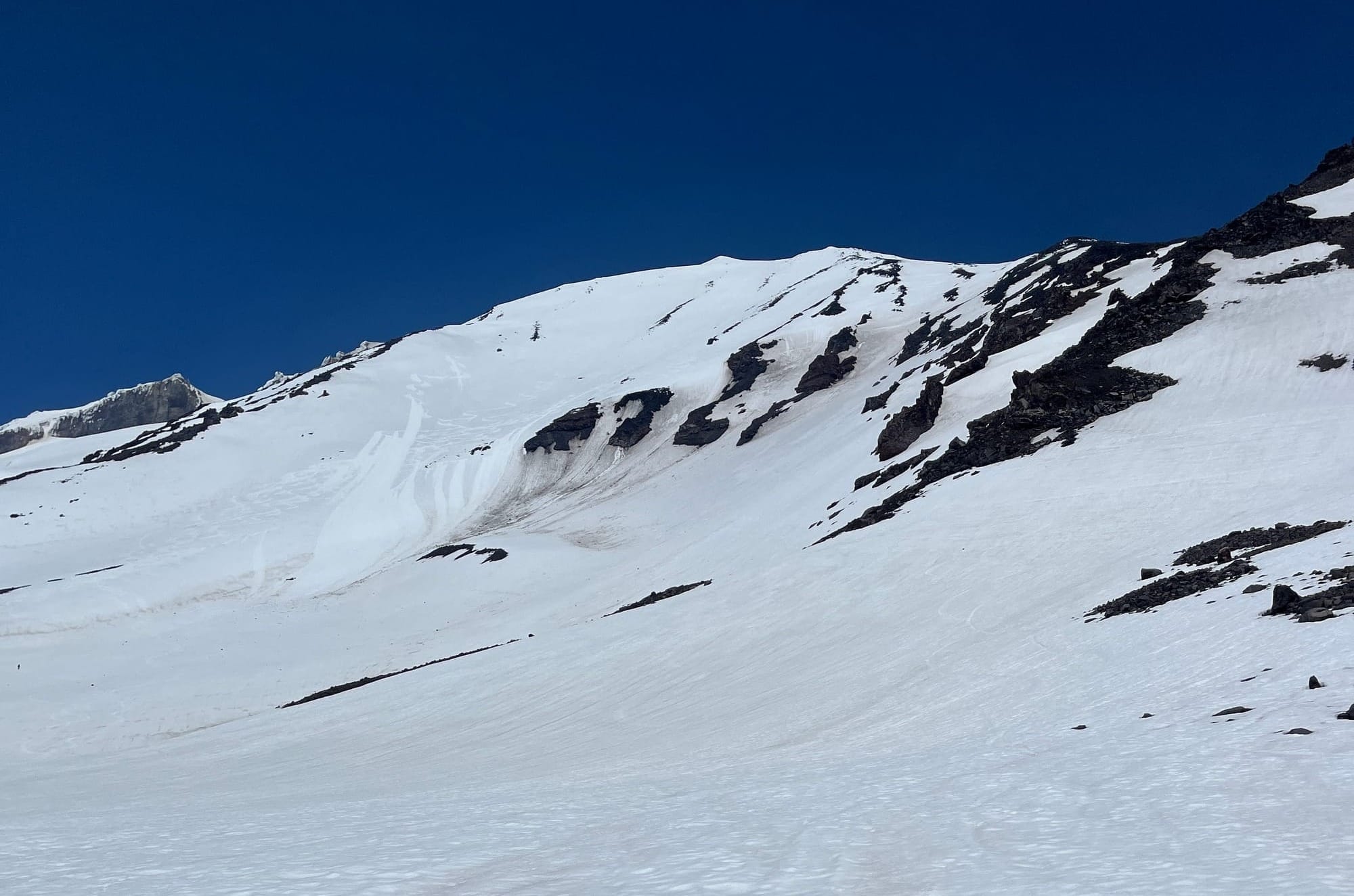
The group came in around me and we reassessed the situation, picking our line and trying to move quickly through the most consequential terrain. Not long after, a group above us triggered a slide, the wet snow slid down the slope for 1,500 ft crossing between our party. Luckily we had put ourselves in a good position and there weren't any hazards beneath us had the slide taken anyone for a ride, but we were on edge. We maneuvered around the slow, continuously creeping snow stream and traversed out of the line.
It was hot down here below 7,000 ft and we stripped off as many layers as we could once we were finished with the skiing. We slowly slogged out, absolutely drenched in sweat as we swapped back and forth between short stints of skiing and quick hikes over exposed rock and dirt. We finally made it back to the cars after 13 hours on the mountain, out of water and with legs made of jello.
The Three-peat
After having summited Adams, and experienced all the suffering the warm exit had entailed, I put it out of my mind for the next season. I explored around the state more, and kept my eyes out for conditions for other mountains, both Hood and Rainier high on my list. Yet, anyone who was in Washington for the 24/25 season knows just how strange the weather patterns were. Between a dry winter, a wet spring, and my own issues timing objectives with partners – nothing seemed to be working out. By May I had essentially resigned myself to a volcano-summit-less-year, content with other big days I had managed and excited to start trail running again as the mountains began to dry out.
Secretly lurking however, Mt. Adams would spring back into my season just as surprising as it had the year prior...

The second week of June I got together with my buddies Jason, Hugo, and Julian to discuss plans around a great high pressure spell throughout the region, initially wanting to use this window to summit and ski Mt. Hood. However, conditions on Hood were looking dire. After all of the heat, most of the routes were melted out and rocky, bringing with it overhead hazards and terrible skiing. We looked around at other trip reports, deliberating between mountains while sitting at a small table in Rosita's Green Lake. One of those objectives was the Southwest Chutes, it was looking in good condition as June typically did, much better than it's cousin to the south. Everyone had summited the mountain before, but I was the only one lucky enough to have properly tagged the chutes. So, it was decided, we would head back out, forgoing the summit to focus on getting prime ski conditions to finish off our season.
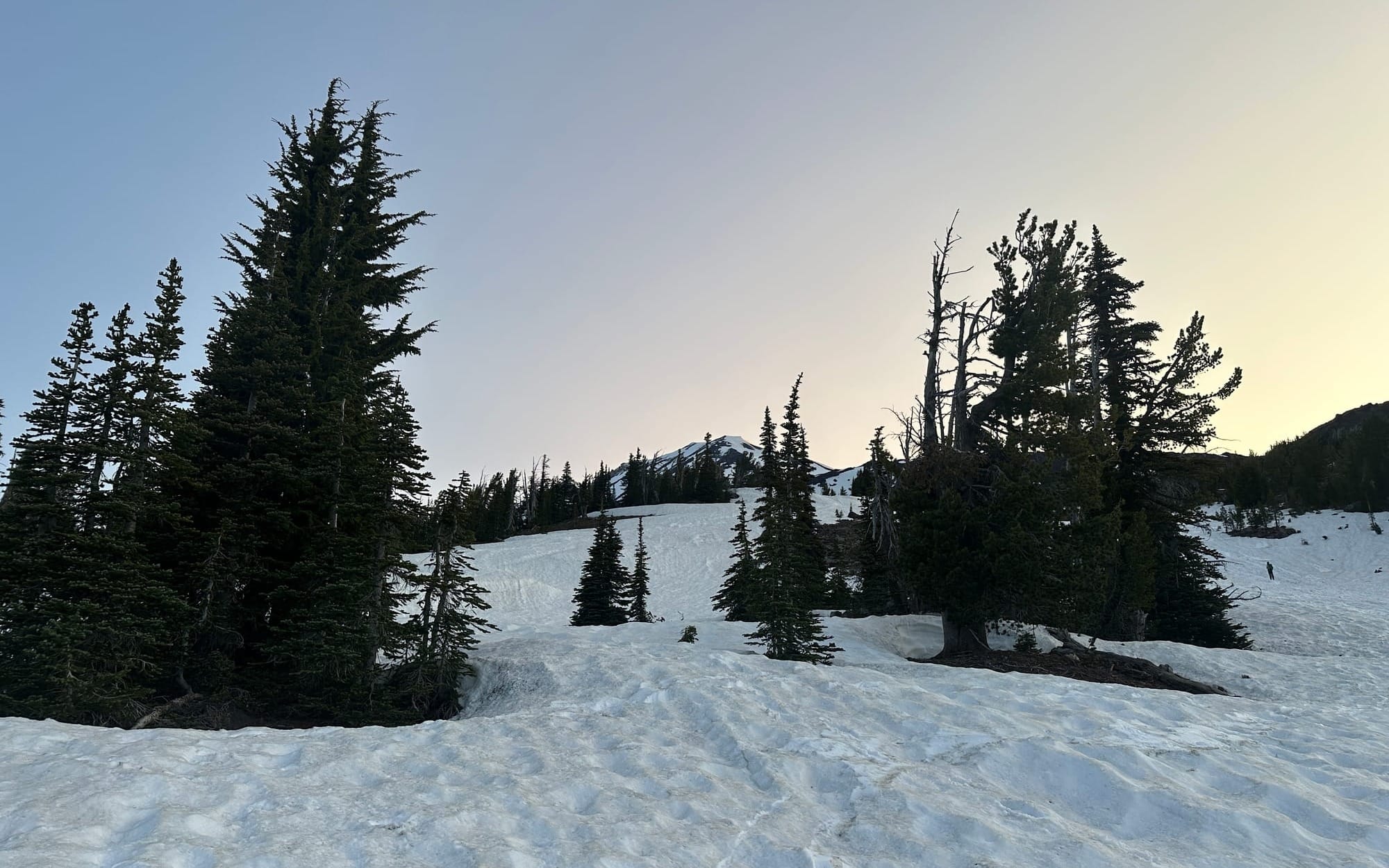
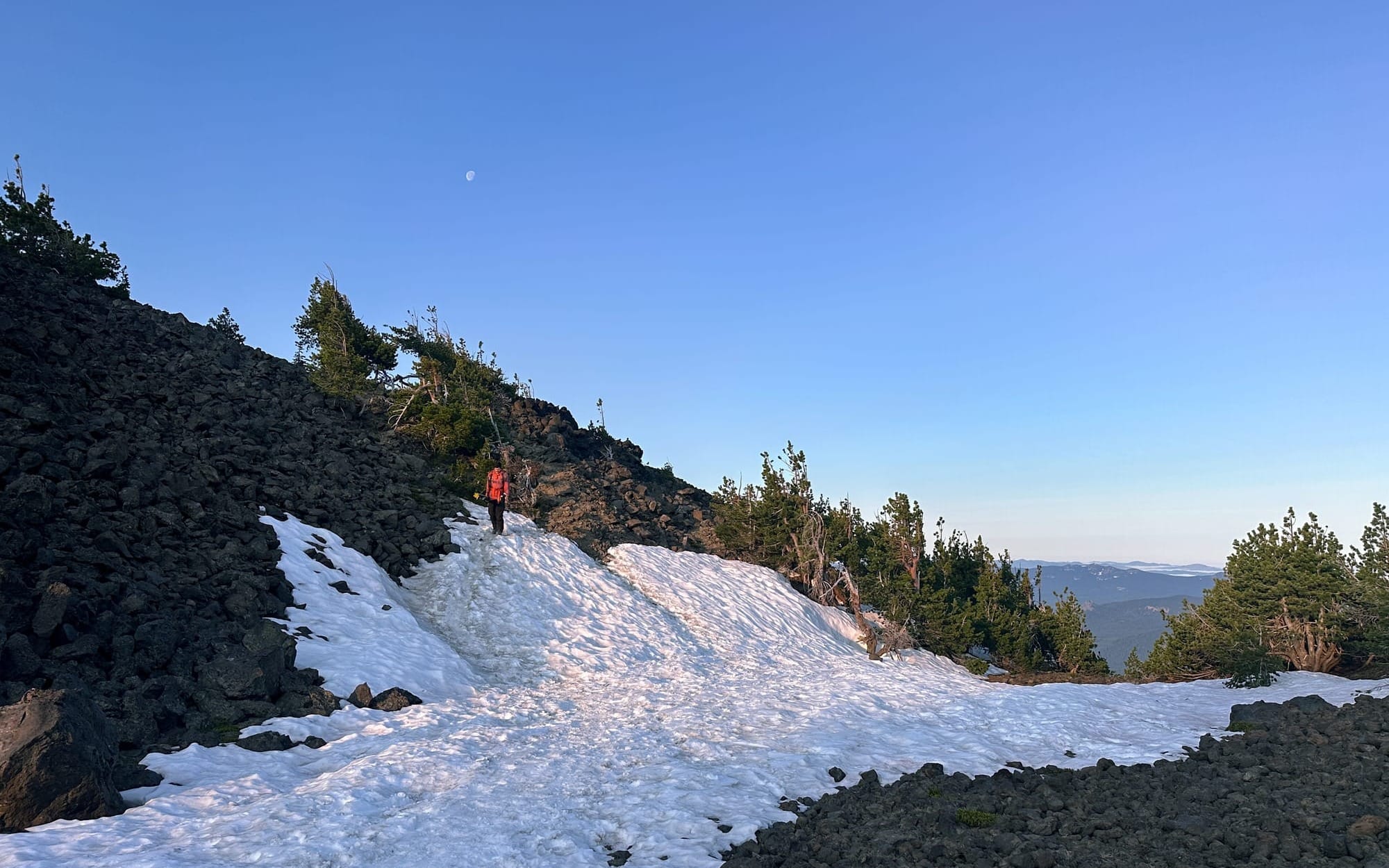
We drove up Saturday, once again car camping at the Cold Springs Trailhead for an early wake up call the next day. We wouldn't start till 4:00 AM given our non-summit goal and the expectation of good ski conditions not hitting their peak until noon. The South Climb went similar to the past attempt, hitting snow and hanging our trail-runners in a tree around 6,500 ft and then meandering where ever we could stay on snow to climb higher. Despite being almost a month earlier than my previous attempt it was lower-tide, and multiple times we had to take off our skis and boot over short sections of rock to continue onward. We had seen the chutes from afar and they seemed still very in, but this worried me for the exit which already required plenty of shenanigans even with more snow.
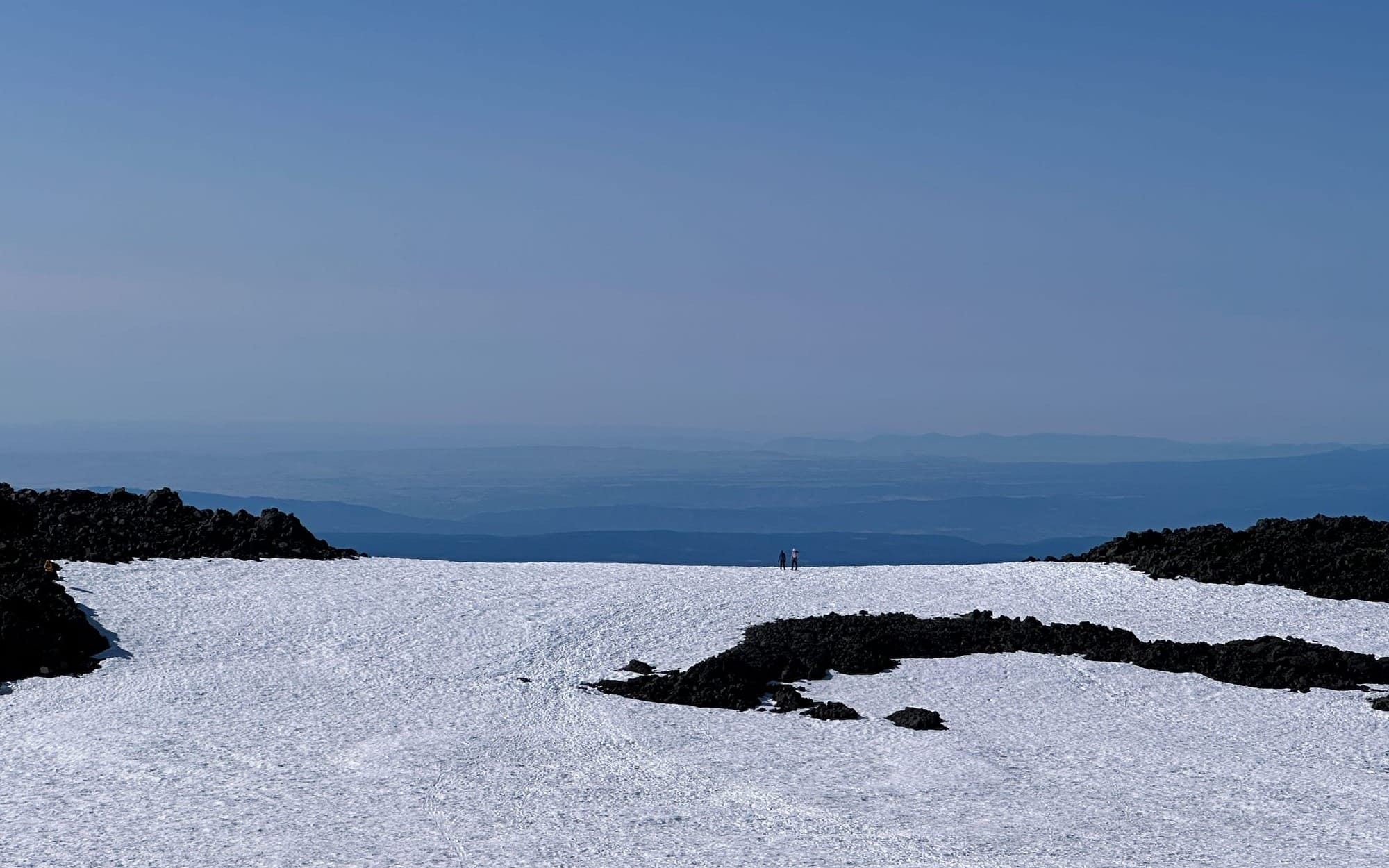

Julian had brought his dog, Zora, ( one of the other benefits of skiing on National Forest land) and she was struggling on the hard icy snow enough that they had fallen behind us. Our original plan had been for them to make it up Pikers, but not attempt the chutes (bringing a dog on 35°+ was a scary thought), but after the pacing issues we decided to split up there, leaving Julian to ski down from the lunch counter with Zora while we ascended higher.
I never like to split up a group, but we had radio contact and the south side of Adams is a fairly straightforward solo mission anyways. Jason, Hugo, and I started up the Pikers climb each choosing a slightly different variation of when to switch from skis to boots, testing out which seemed like the faster method of travel.
"Bonking" is a term, originally coined by cyclists, but now adopted by many different endurance disciplines, to denote when an athlete suddenly runs out of energy, typically caused by the depletion of their glycogen (glucose based energy) stores. You may have heard of "hitting the wall" in a marathon which is often the same thing.
I was feeling great, and let myself get a bit ahead of Jason and Hugo on the climb. When I was getting close to the top they radioed to me and told me they felt like they were "bonking" and needed to take a longer rest before they continued on. Rather than sit on top of Pikers for an hour, I decided to push on to the summit (with their blessing) and would attempt to meet them back as they reached the entrance to the chutes. I picked up my pace just a bit more and resolved myself to take no more breaks to make sure I didn't cause them to wait, if I couldn't summit in an hour I would turn back wherever I was.
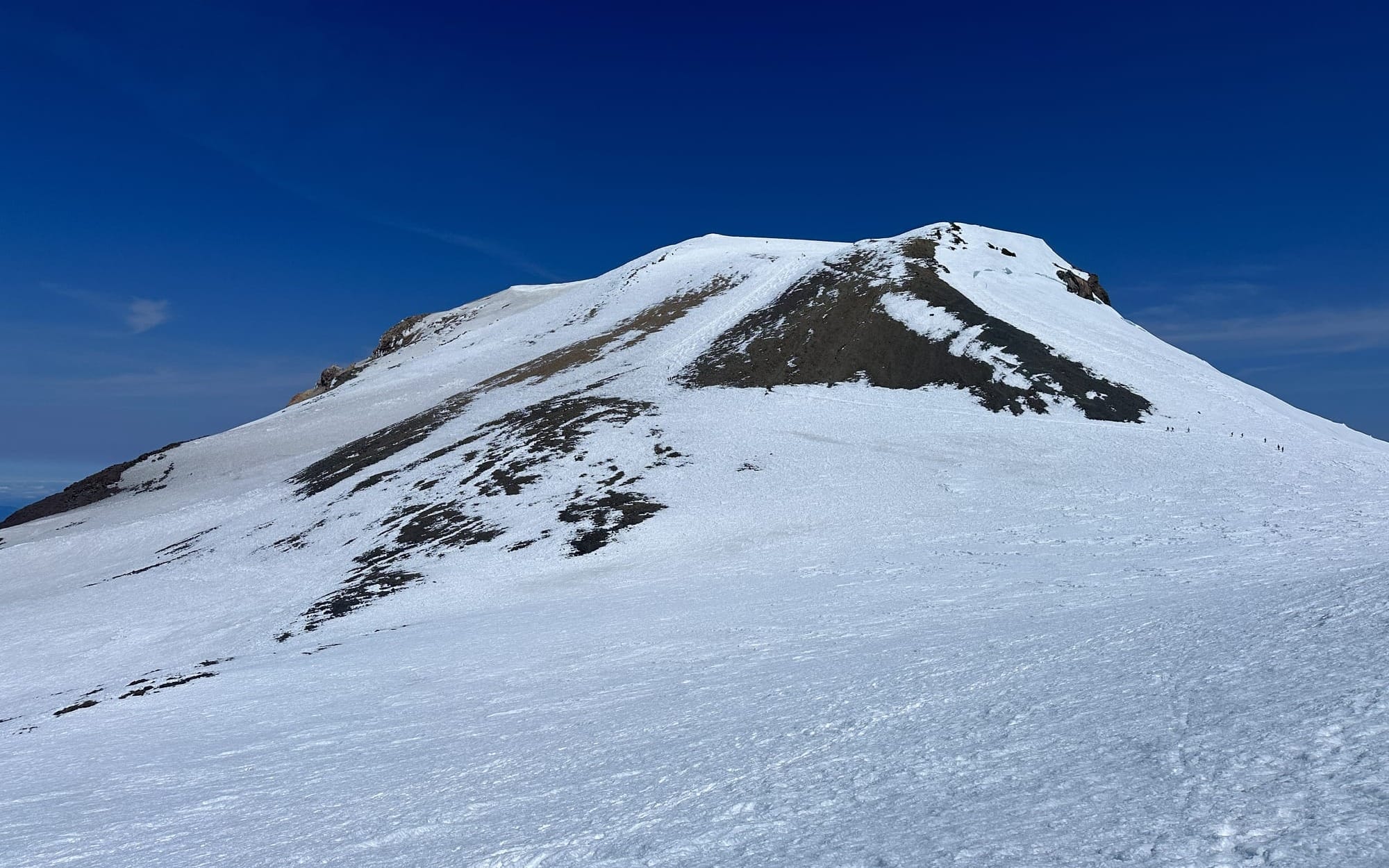
As soon as I crossed over 11,000 ft the altitude hit me again, not quite as bad as last time, but enough that I was impacted noticeably. Across the long flat to the summit block I struggled to walk a straight line, despite my legs feeling fine my body as a whole felt exhausted. I felt locked inside of myself, moving only because my legs went on without explicit instructions from my brain to do so.
There is a curious mental space you can enter when you are pushing hard, (some people call it the "pain cave") when you get so tired that you feel like you are looking out from inside of yourself and your subconscious starts to bargain with you. It starts to spin stories about about how incredible it would feel to stop and rest. It tries to convince you there isn't any reason to put yourself through this, that it's meaningless. The hardest part about this is that it's always right, and it repeats these things over and over again, trying to beat you down. Yet, something inside of you, whether you call it will or stupidity, can override those thoughts and keep your body moving with simple impulse, turning your limbs over like simple machines.
In the moment I couldn't have said why I continued pushing there, why I didn't slow down or turn back. My subconscious was right! I had been there before, there wasn't any glory, any new viewpoint, any realization I was going to find about myself. It was all arbitrary. All I knew was that I wanted to be moving. I wanted to feel that simple repetition of my crampons crunching in the snow, of my heartbeat thumping through my ears. It felt good, despite feeling bad. That last hour felt as though it could have been as long as the entire day up to that point, time stretching out in my head as I stared down at my feet. Eventually the slope eased and I found myself looking out at a bright blue panorama. The summit was full of activity, a group of a dozen or so guys were partying, one of them even smoking a cigarette. I must have looked haggard because they all cheered me on and welcomed me to the summit when I got there. The people in the mountains are wonderful even if they are humbling. There's always a bigger fish...
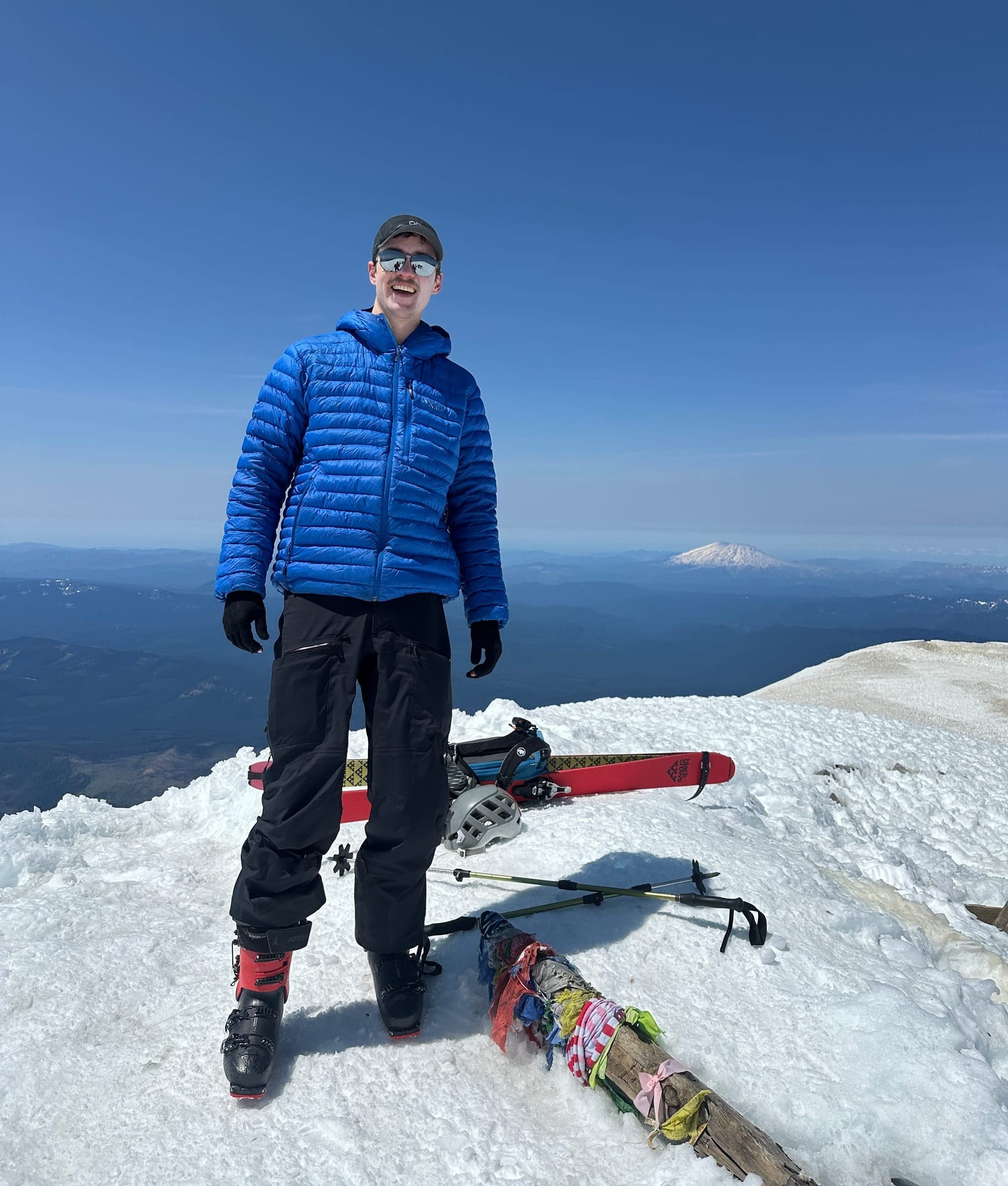
I had made the push from pikers to the summit in 55 minutes, ecstatic at that pace and happy to have far less of a headache than the last time I sat on the summit. I planted myself on the remains of the lookout, eating sour patch kids and gazing out over the hazy horizon, before radioing down to the boys that I had made it and I would be skiing down to them shortly. The timing had been perfect, they had just made it to Pikers, so I transitioned my skis, repacked my bag, and headed down to them.
The low-tide continued even at the summit, much of the south face was bare, leaving only a sliver of skiable snow that had formed moguls from all of the traffic coming through. I tried my best to connect my turns and look like a proper ski mountaineer as I passed the conga-line of people making their way up to the summit (I had to take 4 or 5 breaks before I made it to the traverse ✌️). All told it took me about a half hour to make it to the entrance of the chutes. The lower altitude reinvigorated me once again and I sat in the sun, enjoying the accomplishment, while I waited on Jason and Hugo's transition. I had met one of the guys at the summit, John, who came in just a moment after me and asked if he could join us on the descent so he didn't make a wrong turn.
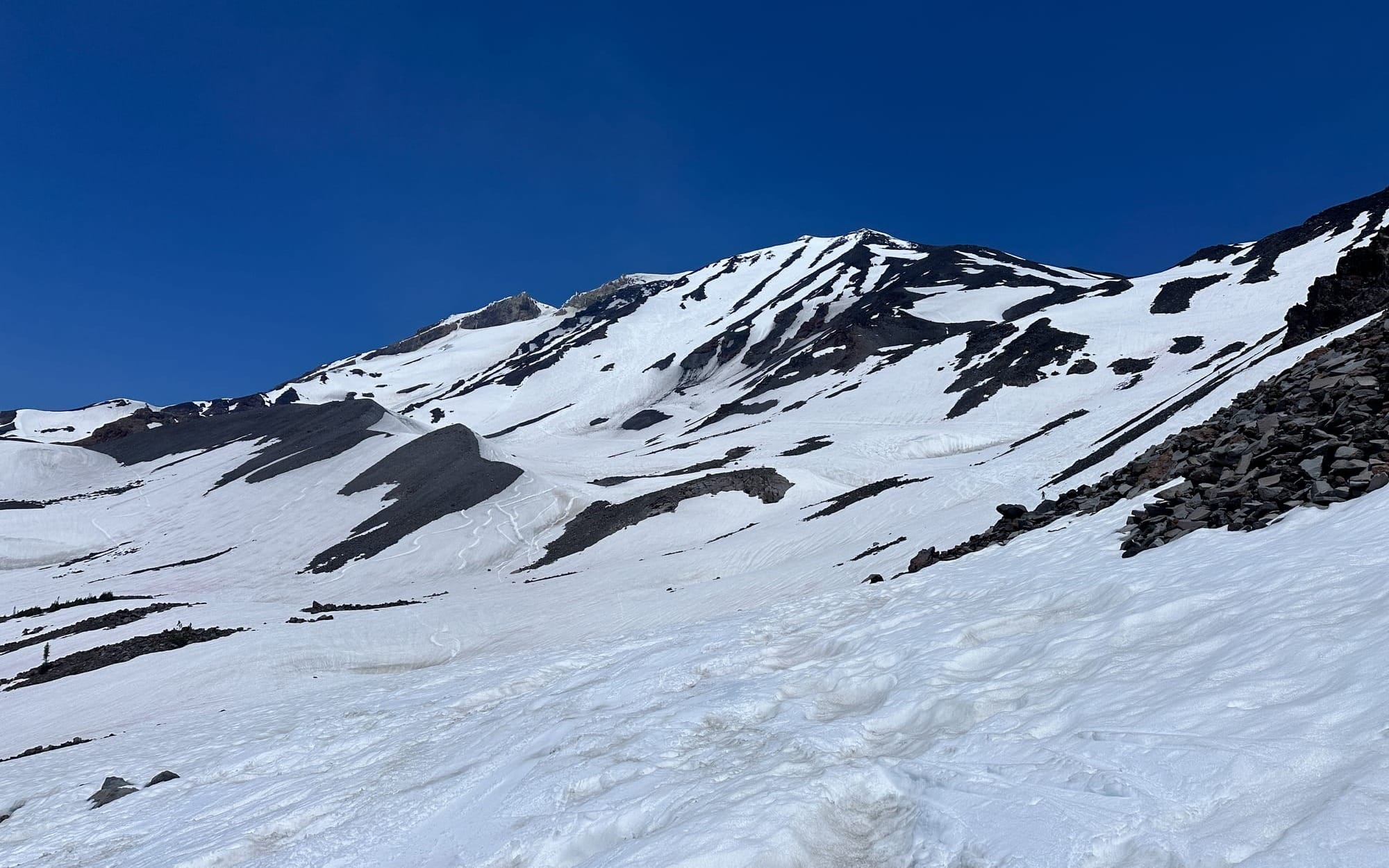
So, our little group became four again, and we descended into immediate corn on the chutes. The skiing was amazing, just as I had remembered, steep but controllable with endless views. What a place! Of course, in classic me fashion, I hit a hard refrozen rollerball and high-sided... sliding 20 or so feet before managing to get my skis under me again. A little shaken by yet another fall on the chutes, I took the rest of the line slower, fearful that I would hit the horrible rotten slush at any moment. Luckily, we got fairly consistent skiing through most of the line, only the very bottom started to become a more mashed potatoes consistency. We danced around the exposed rocks and tried to traverse over to the semi-bare exit without having to take off our skis (we managed with only one walking section).
At the end of the line we stopped and debated the route for a while. The path I had taken before required one more transition, skinning uphill for ~300 ft and then crossing multiple rock bands. Another option was to drop down from here to the "Round the Mountain" trail and walk back (in our ski boots) to the Timberline camp where our trail runners were stashed. We chose the high route, wanting to avoid walking in our boots, but said goodbye to our new friend John who had walked his non-split snowboard up the mountain and had his shoes with him (spoiler alert: John would beat us to the cars by an hour).
After skinning up hill, skiing, taking off our skis, walking across dirt, skiing, taking off our skis, walking across dirt (over and over again) we discovered we had gone too low at some point and decided to give in. We strapped our skis back on the pack and walked downhill until we reached the "Round the Mountain" trail and hiked back. Sadly when we reached the junction our shoes were 200 ft uphill, so I dropped my bag and ran ahead to collect them.
Taking of sweaty ski boots in favor of trail runners is a magical feeling, even when you know you have to add the boot weight to your pack for the rest of the hike out. It's those little things that matter so much on a type 2 kind of day.
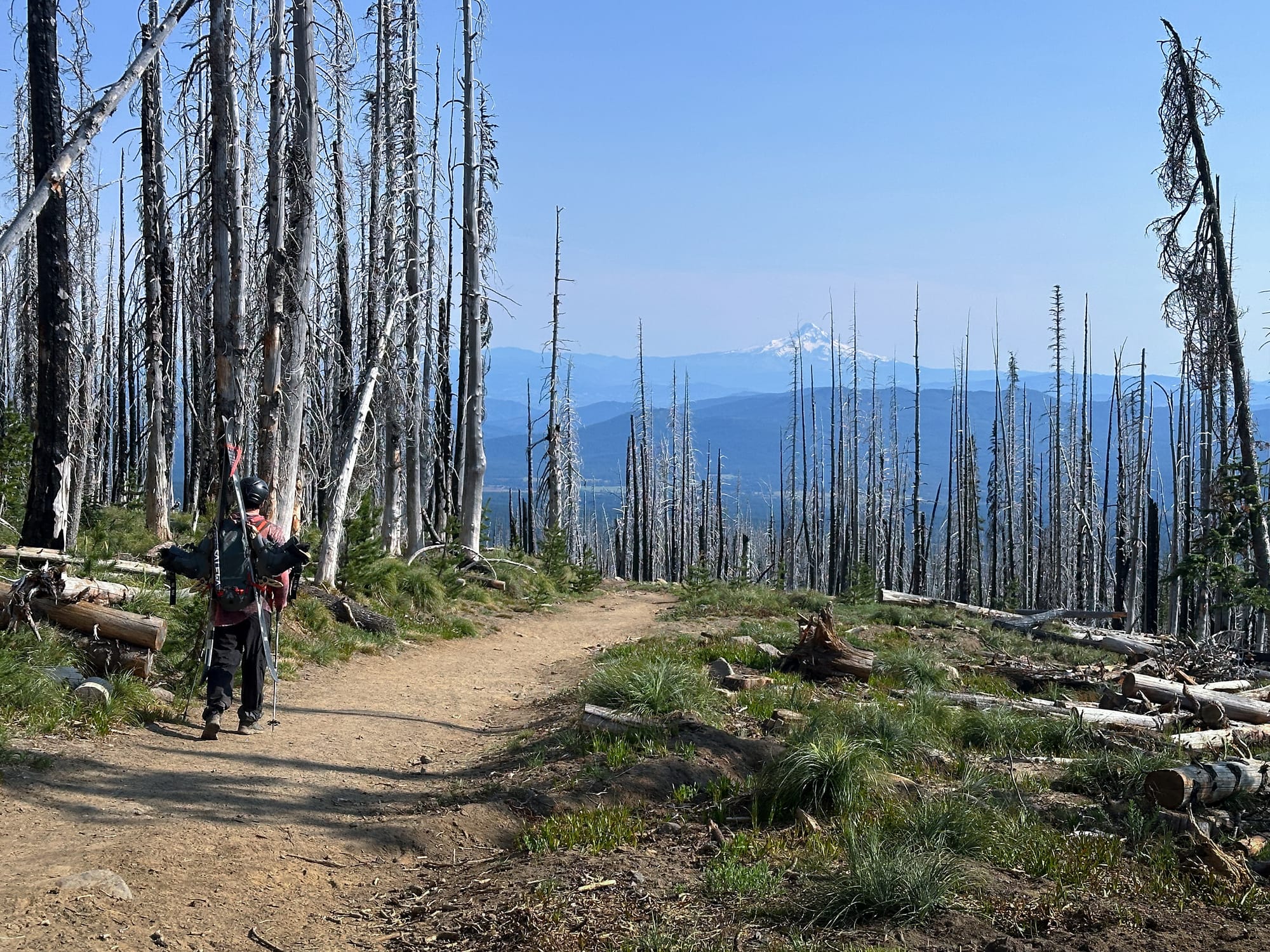
All in all, this trip took us almost exactly 14 hours. With my summit push it ended up being a 7,600 ft day, but would be about 1,000 ft less if you just did the chutes.
So, What Do I Need To Know?
That was a lot of backstory for a post called "A Dummies Guide to Ski Mt. Adams". I feel like an online recipe writer, adding my whole life story before giving you the ingredients list to chocolate chip cookies...
I do hope the personal experience will help someone glean some kind of insights into what this undertaking means to someone who is not entirely used to the big mountains, and prove that (while i'm certainly entertaining no ideas of being an "expert" on this mountain or any other) I have enough real experiences to back up the advice that I give here. So, for those who want some beta on the line, here ya go.
When should I go?
Typically Mt. Adams south end is accessible in the late spring, typically sometime in May depending on how far up you want to be able to drive. The two roads you need to monitor for access to the South Climb trailhead are NF-8040 and NF-500 which lead to the "Cold Springs Trailhead". These can be monitored via Gifford Pinchot National Forest Service site:
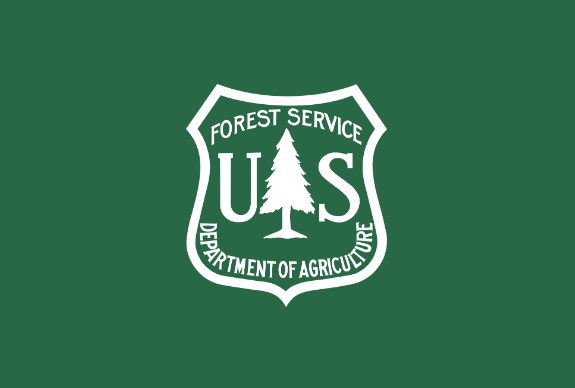

If NF-8040 is open but NF-500 is still showing blockage you just need to account for additional mileage added to your day. Many people ski Mt. Adams earlier even when there are multiple miles of skinning or walking required to reach the south climb.


One of the things most people are looking for when skiing any volcano is CORN! Getting into the exact theory of how to time corn perfectly could take up an entire blog post of its own, but there are a few basic tips I have found, especially for the specific SW aspect of the chutes on Adams, to be helpful.
- The snow needs to refreeze overnight to produce true corn, watch the temps and freezing level
- Look for clear nights and sunny days, especially when this repeats for an extended period of time
- Pay attention to the snow surface as you are climbing to check for the compact icy snow and the formation of the little corny bumps
- The refrozen snow needs to warm up, ideally with a bit of sun
- Don't hit your line until the sun has started to hit, but once it hits you need to be quick or it can get too slushy!
- While very specific conditions are required for "true" corn, there are plenty of enjoyable spring surfaces that can feel pretty corn-like
I have found when skiing in "summer" conditions this can be anywhere from 11 AM to 1 PM (or not happen at all) depending on the conditions you have. No one can figure this out exactly for you, but you can practice and ask others for recent info, its all preparation!
What do I bring?
Mt. Adams is a pretty straightforward volcano for skiing, there aren't any glacier hazards on the south route so, as long as you don't get way off route, you can leave the rope and glacier kit at home. I have a few pieces of gear for volcanos in general that I prefer, though I've seen people without them, or with things I don't carry, it's all personal preference so take these recommendations how ever you want.
- Helmet (duh)
- Melting and warming can bring open up rocks that where once held together by snow or ice, bringing rockfall in the spring and summer, watch your noggin!
- Ski crampons
- Some people love them, some don't, but for me they definitely speed things up in the early morning when the snow is its hardest. It's a pretty light piece of kit to add and I like the ability to do less switchbacks
- Boot crampons
- I've seen plenty of people get away without boot crampons, Adams is popular and there is a pretty consistent good booter set. For me personally they add a confidence to my step that keeps me moving fast and falling in a busy spot feels like a huge disaster, so I keep the spikes on
- Ice Axe
- Some people never pull theirs out, but almost everyone I see is carrying one
- At the top of the Pikers climb it get quite steep, enough that holding non-huge-gripped-poles can become awkward and an axe becomes far more comfortable in my opinion
- I would rather be able to self-arrest than taking a 2,000 ft slide if some accident did happen 🤷
- Plenty of water
- Unlike other spots in the cascades we found very litte running water sources on the approach or descent
- It gets hot at 6,000 ft when you are timing for corn at 10,000
Otherwise treat this like any other ski tour you are going on: layer for the weather, pack enough food to not bonk, and pick your favorite light pair of skis!
Where do I go?
I outlined the south climb trail milestones in the beginning of this post, so let's focus primarily on the descent now. Don't worry, the south climb is very straightforward, in fact you can see pretty much where you are going the whole morning, Pikers is visible from almost every spot on the climb.


When leaving the summit you will be able to see Pikers below you, back the way you came. Its the large hump skiers left as you make your way down down. Follow the approach trail traversing the flat spot, and just before you would crest the ridge to return to the south climb trend further skiers right into the obvious funnel. There will be multiple entry points, there often appear to be three chutes - though conditions may cause these to appear joined or split further, no matter what you see if you want to ensure you don't end up on Avalanche Glacier hug skiers left.

Once you are in the chutes you will be able to see the entirety of the line, thanks to the steepness of the mountain. Depending on how you entered the fall line may draw you towards a slightly different drainage. Again here, hug skiers left especially as you descend further down. By 8,000 ft you should be traversing to the left-most rock band where you will continue down a mellow slope to the exit of the line, around 7,000 ft.
Here you will be able to decide which route off the mountain you will take:
A hard left around the end of the rocky ridge will allow you to begin traversing the mountain. You'll reach another drainage where you will have to transition, and skin back up to ~7,400 ft where you can traverse back to the south climb. This is the line I took in both of my trips. You need to continue staying as high as possible, even when this means skiing for a few hundred feet to the next rock band, taking off your skis, walking over, and repeating again and again. If you manage to stay above 7000 ft you will eventually connect again with the south climb trail where you can ski down to stashed shoes at the junction.
If you continue heading down, you can ski for another 1,000 ft (or until the snow runs out) and you will eventually reach the "Round the Mountain" trail where you should transition and start walking back to the junction. Roughly plotted on a map this is +/- a two mile walk to the junction. I haven't taken this route, but it seems like a good option, especially if you are okay carrying shoes all day.
If I were to do this again (and I'm sure I will) I would vote to carry my shoes with me, or walk in my ski boots on the "Round the Mountain". Dealing with the constant on and off of the skis on the "normal" descent is tedious and annoying when you are already tired from a full day. Though, until I have actually completed that route, I will give that advice with a grain of salt!

I've included the complete tracks from both successful trips of mine here, you can see that they follow slightly different lines both on the up and down, depending on snow conditions and decision making on the day.
I hope the information this dummy has provided will be helpful to someone, I know I will be returning to it in the years to come to plan my trips. Let me know if you use these tips, or if there are any I should add.
I hope to see you out there!
